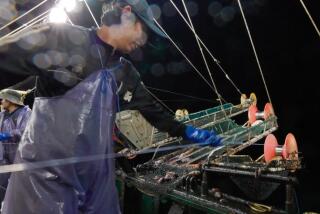Dolphin Delicacy’s Profits Tempt Peruvian Poachers
- Share via
PULPOS, Peru — Over the noise of the pounding surf, Maria Serenella heard the harpooned dolphin squealing as the fishermen lifted it out of the sea into a wooden rowboat before clubbing it to death.
“I was screaming. I was crying. But what could I do?” Serenella recalled recently at her airy three-story oceanfront beach house some 22 miles south of Lima. “I never knew they killed dolphins.”
Illegal for more than a decade, the harvesting of the intelligent sea mammals continues in Peru, where it supplies a black market for a salty delicacy known as muchame.
Stefan Austermuhle, director of the local preservation group, Mundo Azul, said the 10 dolphins Serenella saw killed by fishermen in a single weekend would have yielded enough meat to make 800 plates of muchame.
“It is a simple calculation to see that there is a much larger market than we had thought,” he said.
In his office, the German biologist ran through a collection of photos of slaughtered dolphins that he has taken during trips up and down Peru’s coast. The carcasses all bore the telltale marks of poachers -- stripped clean of the muscle running down their backs.
Although risky to the poor fishermen who face losing their licenses for six months and up to three years in jail if caught, filling orders can pay relatively well.
With buyers offering about $17 a kilogram for the meat used to make muchame, an average-sized dolphin can bring in about $340 -- roughly what a Peruvian schoolteacher or police officer makes in a month.
Austermuhle, who came to Peru four years ago, calculates that at least 1,000 dolphins and porpoises are killed each year off Peru. That number is down from more than 18,000 killed annually in the mid-1990s.
Although killing dolphins and the sale of their meat has been illegal in Peru since 1990, offenders largely went unpunished until the mid-1990s, when activists began campaigning for the Fisheries Ministry to enforce laws and for Lima municipal authorities to pull the licenses of restaurants serving dolphin.
The campaign also led the government to decree a new law in 1996 criminalizing the consumption of dolphin meat.
The taste for muchame was apparently brought to Peru in the 1960s by Italian immigrants. Made from the salted and dried back muscle, it was shaved into thin slices and served on crackers at cocktail parties.
In the 1970s, poorer Peruvians began eating a less expensive cut of dolphin meat, which was called “sea pork.” The 1996 crackdown largely dried up sea pork sales, but merely sent the muchame market underground.
No longer on menus, muchame can still be found in some restaurants and bars that offer it in back rooms to well-known customers. Outsiders interested in tasting muchame have a hard time coming by it, however.
In Lima’s southernmost coastal suburb of Chorrillos, Luz Martinez, 42, said it has been years since dolphin meat passed through the fish market, where she has worked since she was 12.
“But it is still around. It’s sold directly to the restaurants now. It is a mafia,” she said, smiling.
Motioning with a nod past the market’s small harbor, where two dozen brightly painted wooden fishing rowboats bobbed under a midmorning sun, she said excellent muchame could be found in Callao, Lima’s port city at the other end of the capital city’s coastline.
In Callao’s historic La Punta district, a waiter in a seafood restaurant told an inquiring foreigner that muchame is illegal and not available anywhere. Except at the bar down by the port authority, which was known to sell it on the sly, he added quietly.
“Oh, no, sir. Muchame is totally prohibited,” said a waiter at the suspect bar.
Austermuhle said sustained hunting by poachers who return to the same fishing spots could deplete dolphin communities and lead to “local extinctions,” since coastal dolphin families stick to 25-mile stretches of shoreline territory.
In addition to documenting killings, Austermuhle has also launched a program to educate schoolchildren and help organize citizen watch groups.
Austermuhle said a trip last year to a school in the fishing town of Pucusana, 31 miles south of Lima, paid off.
A few weeks after the visit, two 12-year-old students marched down to a port authority office and turned in a band of neighborhood poachers.
More to Read
Sign up for Essential California
The most important California stories and recommendations in your inbox every morning.
You may occasionally receive promotional content from the Los Angeles Times.













